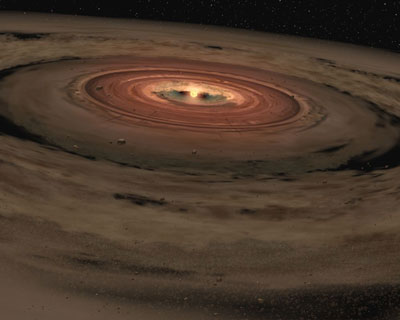| Aug 16, 2012 |
Exoplanet hosting stars give further insights on planet formation
|
|
(Nanowerk News) An international team, led by EXOEarths researchers (Centro de Astrofísica da Universidade do Porto - CAUP), proposes that metals like Magnesium might have an important role in the formation of low mass planets.
|
|
The team, lead by CAUP researcher Vardan Zh. Adibekyan, analyzed high resolution spectra of 1111 sun-like stars, obtained by the HARPS spectrograph (ESO). Of these stars, 109 are known to harbor high mass (Jupiter-like) planets, and 26 have Neptune-like planetary companions.
|
 |
| Swirling disk of planet-building dust. (Credit: NASA/JPL-Caltech/T. Pyle (SSC))
|
|
The team focused especially on studying the abundance of Alpha Elements in these stars, like Magnesium (Mg), Silicon (Si) or Titanium (Ti). The research found that the ratio of these, compared with the amount of Iron (Fe), was consistently higher in stars with planets, with the greatest discrepancy observed for Mg.
|
|
The lead author of the paper ("Overabundance of α-elements in exoplanet-hosting stars"), CAUP Astronomer Vardan Zh. Adibekyan commented “These findings indicate that some metals other than iron are involved in the process of planet formation, especially when the amount of iron is lower than solar. These results may provide strong constraints for the models of planet formation, especially for planets with low mass.”
|
|
The leading theories of planet formation suggest that planets form by clumping smaller particles of heavy elements (metals), into larger and larger bodies. The results put forward by the present study suggest that planets need a minimum amount of “metals” to be formed. The formation of planets, even the lowest mass ones, is dependent on the dust content of the cloud that gave origin to the star and planetary system.
|
|
Notes: Alpha elements are integer multiples of the mass of the helium (He) nucleus (also known as alpha particle). As an example, adding an alpha particle (He nucleus) to a Carbon atom results in an Oxygen atom, and adding an alpha particle to that, originates a Neon atom.
|

